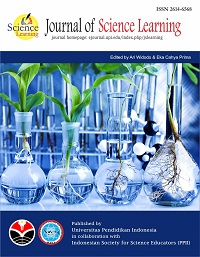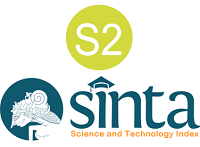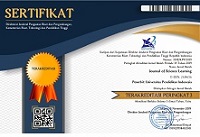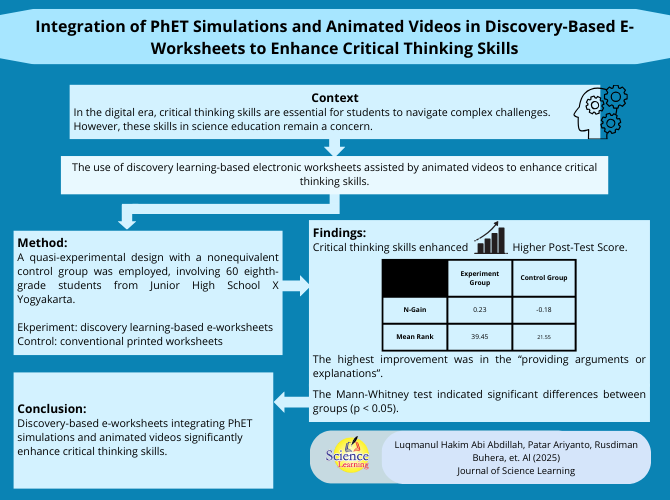
Integration of PhET Simulations and Animated Videos in Discovery-Based E-Worksheets to Enhance Critical Thinking Skills
Abstract
Keywords
Full Text:
Download PDFReferences
Abdelmoneim, R., Hassounah, E., & Radwan, E. (2022). Effectiveness of virtual laboratories on developing expert thinking and decision-making skills among female school students in Palestine. Eurasia Journal of Mathematics, Science and Technology Education, 18(12). https://doi.org/10.29333/ejmste/12708
Anisa, V. M., & Astriani, D. (2022). Implementation of PhET simulation with discovery learning model to improve understanding of dynamic electricity concepts [Implementasi Simulasi PhET dengan Model Discovery Learning untuk Meningkatkan Pemahaman Konsep Listrik Dinamis]. Jurnal Pijar Mipa, 17(3), 292–301. https://doi.org/10.29303/jpm.v17i3.3438
Anwar, Y., Slamet, A., & Daniaty, U. (2023). Improving critical thinking skills through discovery learning models assisted animation video on digestive system material [Peningkatan Kemampuan Berpikir Kritis melalui Model Discovery Learning Berbantuan Video Animasi pada Materi Sistem Pencernaan]. JPBI (Jurnal Pendidikan Biologi Indonesia), 9(3), 433–444. https://doi.org/10.22219/jpbi.v9i3.29042
Arviani, F. P., Wahyudin, D., & Dewi, L. (2023). Role of teaching strategies in promoting students’ higher order thinking skills and critical thinking dispositions. International Journal of Learning, Teaching and Educational Research, 22(9), 332–349. https://doi.org/10.26803/ijlter.22.9.19
Azhar, Manik, R. E., Nabila, R., Natuna, D. A., & Irawan, D. (2024). Critical thinking skills of students through guided discovery learning model assisted by PhET media on stationary and walking wave [Kemampuan Berpikir Kritis Siswa Melalui Model Pembelajaran Guided Discovery Learning Berbantuan Media PhET pada Gelombang Diam dan Gelombang Berjalan]. Jurnal Penelitian Pendidikan IPA, 10(7), 3548–3555. https://doi.org/10.29303/jppipa.v10i7.7212
Banda, H. J., & Nzabahimana, J. (2021). Effect of integrating physics education technology simulations on students’ conceptual understanding in physics: A review of literature. Physical Review Physics Education Research, 17(2), 23108. https://doi.org/10.1103/PhysRevPhysEducRes.17.023108
Bano, M., Zowghi, D., Kearney, M., Schuck, S., & Aubusson, P. (2018). Mobile learning for science and mathematics school education: A systematic review of empirical evidence. Computers and Education, 121, 30–58. https://doi.org/10.1016/j.compedu.2018.02.006
Best, J. W., & Kahn, J. V. (2006). Welcome to research in education. http://www.ablongman.com/researchnavigator.com
Brydges, C. R. (2019). Effect size guidelines, sample size calculations, and statistical power in gerontology. Innovation in Aging, 3(4), 1–8. https://doi.org/10.1093/geroni/igz036
Christina, S., Sitompul, S. S., & Oktavianty, E. (2022). Remediation of misconceptions of simple machines using STAD-type cooperative learning model at SMP Yakhalusti Pontianak [Remediasi Miskonsepsi Pesawat Sederhana Menggunakan Model Pembelajaran Kooperatif Tipe STAD di SMP Yakhalusti Pontianak]. Jurnal Pendidikan Dan Pembelajaran Khatulistiwa, 11(12), 3238–3247. https://doi.org/10.26418/jppk.v11i12.60227
Cisterna-Zenteno, C., Contreras-Soto, Y., Barrera, S. M., Ceballos Muñoz, C., Alveal, D., & Navarrete, D. A. (2022). Undergraduates’ critical thinking skills development through the use of short animated videos during the COVID-19 pandemic. Revista Comunicación, 31, 35–50.
Dong, M., Li, F., & Chang, H. (2023). Trends and hotspots in critical thinking research over the past two decades: Insights from a bibliometric analysis. Heliyon, 9(6), e16934. https://doi.org/10.1016/j.heliyon.2023.e16934
Drastisianti, A., Dewi, A. K., & Alighiri, D. (2024). Effectiveness of guided inquiry learning with PhET simulation to improve students’ critical thinking ability and understanding of reaction rate concepts. International Journal of Pedagogy and Teacher Education, 8(2), 235–252.
Emerson, R. W. (2023). Mann-Whitney U test and t-test. Journal of Visual Impairment and Blindness, 117(1), 99–100. https://doi.org/10.1177/0145482X221150592
Facione, P. A. (2015). Critical thinking: What it is and why it counts (ISBN 13: 978-1-891557-07-1). Insight Assessment. https://www.insightassessment.com/CT-Resources/Teaching-For-and-About-Critical-Thinking/Critical-Thinking-What-It-Is-and-Why-It-Counts/Critical-Thinking-What-It-Is-and-Why-It-Counts-PDF
Fahrunissa, P., Buhungo, T. J., & Pikoli, M. (2023). The analysis of misconceptions in simple airplane material for 8th grade students in SMP Muhammadiyah 3 Gorontalo [Analisis Miskonsepsi pada Materi Pesawat Sederhana untuk Siswa Kelas 8 di SMP Muhammadiyah 3 Gorontalo]. Science Education Journal (SEJ), 7(2), 111–122. https://doi.org/10.21070/sej.v7i2.1649
Fisher, A. (2011). Evaluating inferences: Deductive validity and other grounds. In Cambridge University.
Fitria, A., Utomo, D. H., Mutia, T., & Gadeng, A. N. (2023). Improving critical thinking skills of high school students through gamification-based learning media development. Jurnal Pendidikan Ilmu Sosial, 32(2), 193–200. https://doi.org/10.17509/jpis.v32i2.56997
Flora, Raja, P., & Mahpul. (2020). Discovery learning strategy: Integrating think-pair-share and teacher’s corrective feedback to enhance students’ writing language accuracy. International Journal of Education and Practice, 8(4), 733–745. https://doi.org/10.18488/journal.61.2020.84.733.745
García-Carmona, A. (2023). Scientific thinking and critical thinking in science education: Two distinct but symbiotically related intellectual processes. Science and Education, 34(1), 227–245. https://doi.org/10.1007/s11191-023-00460-5
Gunadi, G., Haryono, H., & Purwanti, E. (2022). The analysis of 21st century learning implementation and competency achievement of junior high school students in 3T regions. Innovative Journal of Curriculum and Educational Technology, 11(1), 10–18. https://doi.org/10.15294/ijcet.v11i1.44847
Hake, R. R. (1999). Analyzing change/gain scores. Measurement and Research Methodology, 1(7), 1–4. http://www.ncbi.nlm.nih.gov/pubmed/22025883
Haleem, A., Javaid, M., Qadri, M. A., & Suman, R. (2022). Understanding the role of digital technologies in education: A review. Sustainable Operations and Computers, 3(February), 275–285. https://doi.org/10.1016/j.susoc.2022.05.004
Heard, J., Scoular, C., Duckworth, D., Ramalingam, D., & Teo, I. (2020). Critical thinking: Skill development framework. Australian Council for Educational Research, September 2021, 1–23.
Hilmia, N., Zaini, M., & Kaspul, K. (2022). Learning outcomes of the Protista concept using electronic worksheets and students' critical thinking skills [Hasil Belajar Konsep Protista Menggunakan LKPD-Elektronik dan Keterampilan Berpikir Kritis Peserta Didik]. Practice of The Science of Teaching Journal: Jurnal Praktisi Pendidikan, 1(2), 44–52. https://doi.org/10.58362/hafecspost.v1i2.10
Karan, E. (2023). Discovery-based approach combined with active learning to improve student learning experiences for STEM students. Journal of Education and Training Studies, 11(4), 16. https://doi.org/10.11114/jets.v11i4.6205
Kefalis, C., & Skordoulis, C. (2025). Digital simulations in STEM education: Insights from recent empirical studies, a systematic review, 1–18.
Khaeruddin, & Amin, B. D. (2020). Development and validation of critical thinking skills instruments of physics subjects. In Proceedings of the 7th Mathematics, Science, and Computer Science Education International Seminar, MSCEIS 2019 (pp. 2–6). https://doi.org/10.4108/eai.12-10-2019.2296474
Khasinah, S. (2021). Discovery learning: Definition, syntax, strengths and weaknesses [Discovery Learning: Definisi, Sintaksis, Keunggulan dan Kelemahan]. Jurnal MUDARRISUNA: Media Kajian Pendidikan Agama Islam, 11(3), 402. https://doi.org/10.22373/jm.v11i3.5821
Kumar, D. (2024). PhET: An interactive simulation technology for learning outcomes based teaching-learning. May, 120–126.
Kusuma, E., Handayani, A., & Rakhmawati, D. (2024). The importance of developing critical thinking skills in elementary school students: A literature review [Pentingnya Pengembangan Kemampuan Berpikir Kritis Pada Siswa Sekolah Dasar: Sebuah Tinjauan Literatur]. Wawasan Pendidikan, 4(2), 369–379. https://doi.org/10.26877/jwp.v4i2.17971
Kwangmuang, P., Jarutkamolpong, S., Duangngern, P., Gessala, N., & Sarakan, P. (2024). Promoting analytical thinking skills development in elementary school students through animated cartoons. Computers in Human Behavior Reports, 15(May), 100467. https://doi.org/10.1016/j.chbr.2024.100467
Laar, E. van, Deursen, A. J. A. M. van, Dijk, J. A. G. M. van, & Haan, J. de. (2020). Determinants of 21st-century skills and 21st-century digital skills for workers: A systematic literature review. SAGE Open, 10(1). https://doi.org/10.1177/2158244019900176
Liswar, F., Hidayati, A., Rayendra, R., & Yeni, F. (2023). Use of PhET interactive simulation software in physics learning. Jurnal Penelitian Pendidikan IPA, 9(Special Issue), 135–142. https://doi.org/10.29303/jppipa.v9ispecialissue.5982
Manurung, A. S., & Pappachan, P. (2025). The role of discovery learning in efforts to develop students’ critical thinking abilities. Journal of Education and Learning, 19(1), 46–53. https://doi.org/10.11591/edulearn.v19i1.21788
Marnita, M., Rahma, R., & Fatimah, F. (2021). Impact of e-learning media on students’ critical thinking skills at physics education study program, Almuslim University. JIPF (Jurnal Ilmu Pendidikan Fisika), 6(2), 131. https://doi.org/10.26737/jipf.v6i2.1908
Muhammad, F. N., Rosana, D., & Hastuti, P. W. (2022). The development of e-worksheet based on discovery learning with Google Docs to improve students’ higher order thinking skills. Journal of Science Education Research, 6(2), 120–126.
Muhayati, E. I., Trisnawaty, W., & Subaidah, S. (2023). Implementation of discovery learning models to improve students’ mathematic learning outcomes. Jurnal Penelitian Pendidikan IPA, 9(5), 3975–3980. https://doi.org/10.29303/jppipa.v9i5.2190
Narayanan, T., & Zainal, M. Z. (2022). The level of critical thinking skills among new graduate nurses through practical learning and theoretical learning. International Journal of Academic Research in Progressive Education and Development, 11(1), 413–427. https://doi.org/10.6007/ijarped/v11-i1/12021
OECD. (2023). Pisa 2022. In Perfiles Educativos, 46(183). https://doi.org/10.22201/iisue.24486167e.2024.183.61714
Ozdem-Yilmaz, Y., & Bilican, K. (2020). Discovery learning—Jerome Bruner. In B. Akpan & T. J. Kennedy (Eds.), Science Education in Theory and Practice: An Introductory Guide to Learning Theory (pp. 177–190). Springer International Publishing. https://doi.org/10.1007/978-3-030-43620-9_13
Paul, R., & Elder, L. (2006). The miniature guide to critical thinking concepts and tools. Performance + Instruction, 4(6). https://doi.org/10.1002/pfi.4170340606
Rahmawati, S., Masykuri, M., & Sarwanto, S. (2021). The effectiveness of discovery learning module classification of materials and its changes to enhance critical thinking skills [Efektivitas Modul Discovery Learning Klasifikasi Materi dan Perubahannya untuk Meningkatkan Keterampilan Berpikir Kritis]. Jurnal Inovasi Pendidikan IPA, 7(1), 74–84. https://doi.org/10.21831/jipi.v7i1.33253
Raj, T., Chauhan, P., Mehrotra, R., & Sharma, M. (2022). Importance of critical thinking in the education. World Journal of English Language, 12(3), 126–133. https://doi.org/10.5430/wjel.v12n3p126
Rohmah, M. M., Hamdu, G., Suryana, Y., Upi, P., & Tasikmalaya, K. (2021). Analysis of misconceptions in simple machine materials in elementary school [Analisis Miskonsepsi pada Materi Pesawat Sederhana di Sekolah Dasar]. Jurnal Ilmu-Ilmu Sejarah, Sosial, Budaya dan Kependidikan, 8(1), 101–110.
Saarsar, P. (2018). Exploring the constructivist approach in education: Theory, practice, and implications. International Journal of Research and Analytical Reviews, June 2018, 716. https://www.academia.edu/117138980/Exploring_the_Constructivist_Approach_in_Education_Theory_Practice_and_Implications
Samitra, D., Firdaus, M. L., & Krisnawati, Y. (2023). Physics Education Technology Project (PhET): Interactive simulation to improve students’ understanding of concepts and perceptions. Jurnal Paedagogy, 10(3), 646. https://doi.org/10.33394/jp.v10i3.7879
Sanders, M., & Moulenbelt, J. (2011). Defining critical thinking. Inquiry: Critical Thinking Across the Disciplines, 26(1), 38–46. https://doi.org/10.5840/inquiryctnews20112616
Saputra, A. R., Wahiidin, & Nur, S. H. (2021). Utilization of web-based multimedia in discovery learning model to improve student learning outcomes and critical thinking on structure and anatomy of the human body [Pemanfaatan Multimedia Berbasis WEB dalam Model Discovery Learning untuk Meningkatkan Hasil Belajar dan Berfikir Kritis Siswa pada Materi Struktur dan Fungsi Anatomi Tubuh Manusia]. Jurnal Bio Educatio, 6(1), 52–62. https://media.neliti.com/media/publications/378901-none-64f4c724.pdf
Sastradewi, N. M. P. (2022). Improving students' critical thinking ability through interactive multimedia based on problem solving in science subjects [Meningkatkan Kemampuan Berfikir Kritis Siswa Melalui Multimedia Interaktif Berbasis Problem Solving pada Muatan Pelajaran IPA]. Jurnal Media dan Teknologi Pendidikan, 2(1), 10–19. https://doi.org/10.23887/jmt.v2i1.44855
Saudelli, M. G., Kleiv, R., Davies, J., Jungmark, M., & Mueller, R. (2021). PhET simulations in undergraduate physics: Constructivist learning theory in practice. Brock Education Journal, 31(1), 52–69. https://journals.library.brocku.ca/brocked
Seden, K., Thomas, D. A., & Rinchen, S. (2023). Effects of self-assessment on students’ evaluative skills: A convergent mixed-methods study at Samtse College of Education. Assessment Matters, February. https://doi.org/10.18296/am.0064
Simbolon, D. H., & Silalahi, E. K. (2023). Virtual laboratory-based physics learning “PhET simulation” to improve student learning activities. Jurnal Ilmiah Sekolah Dasar, 7(3), 461–468. https://doi.org/10.23887/jisd.v7i3.61001
Sriwidadi, T. (2011). Testing Mann Whitney U on the analysis of the influence of sales force training in selling new products [Pengujian Mann Whitney U pada Analisis Pengaruh Pelatihan Wiraniaga dalam Penjualan Produk Baru]. Binus Business Review, 2(2), 751–762. https://journal.binus.ac.id/index.php/BBR/article/view/1221
Subedi, K. (2022). Cognition in the psychological perspectives. ResearchGate, September. https://doi.org/10.13140/RG.2.2.29414.70720
Sudatha, I. G. W., & Simamora, A. H. (2021). The effectiveness of using dynamic visualization in natural science learning to improve students’ understanding in junior high schools. Journal of Educational Science and Technology (EST), 7(1), 32–39. https://doi.org/10.26858/est.v7i1.17681
Sudirman, Megahati S, R. R. P., Agustin, R., Masita, E., & Pranoto, N. W. (2024). E-worksheet to improve critical thinking and scientific argumentation skills: A systematic literature review. Jurnal Penelitian Pendidikan IPA, 10(6), 277–283. https://doi.org/10.29303/jppipa.v10i6.7327
Verawati, N. N. S. P., & Sukaisih, R. (2021). Higher order thinking skills of students in inquiry learning with PhET simulation: A preliminary study [Keterampilan Berpikir Tingkat Tinggi Siswa dalam Pembelajaran Inkuiri dengan Simulasi PhET: Studi Pendahuluan]. Empiricism Journal, 2(1), 40–46. https://doi.org/10.36312/ej.v2i1.591
Vygotsky, L. (1978). Mind in society: The development of higher psychological processes (M. Cole, V. John-Steiner, S. Scribner, & E. Souberman, Eds.; 2nd ed.). Harvard University Press.
Wardani, I. S., Widodo, A., & Munir. (2024). The effect of smartphones media to improve critical thinking skills student of elementary school. Jurnal Penelitian Pendidikan IPA, 10(2), 479–486. https://doi.org/10.29303/jppipa.v10i2.3346
Widyapuraya, N. W., Suryana, A. L., Suyanta, S., & Wilujeng, I. (2023). Profile of students’ critical thinking skills at SMP Negeri 1 Juwangi in science learning [Profil Keterampilan Berpikir Kritis Siswa SMP Negeri 1 Juwangi pada Pembelajaran IPA]. Jurnal Penelitian Pendidikan IPA, 9(3), 1368–1374. https://doi.org/10.29303/jppipa.v9i3.1723
Zajda, J. (2023). Globalisation and education reforms: Promoting engaging learning environments. https://doi.org/10.1007/978-3-031-24400-1_2
Zohar, A., & Barzilai, S. (2013). A review of research on metacognition in science education: Current and future directions. Studies in Science Education, 49(2), 121–169. https://doi.org/10.1080/03057267.2013.847261
DOI: https://doi.org/10.17509/jsl.v8i2.80836
Refbacks
- There are currently no refbacks.
Copyright (c) 2025 Luqmanul Hakim Abi Abdillah, Patar Ariyanto Sitorus, Rusdiman Buhera, Muhammad Ikhsan, Sabar Nurohman, Ismail Fikri Natadiwijaya

This work is licensed under a Creative Commons Attribution-ShareAlike 4.0 International License.
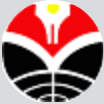

Jl. Dr. Setiabudhi 229 Bandung 40154, West Java, Indonesia





